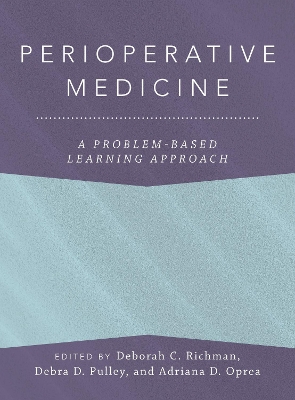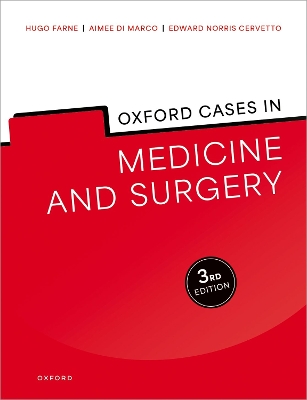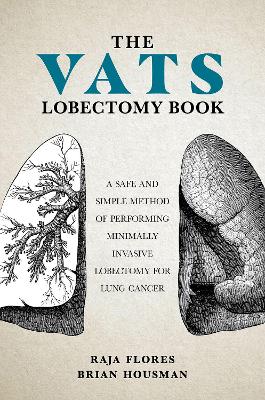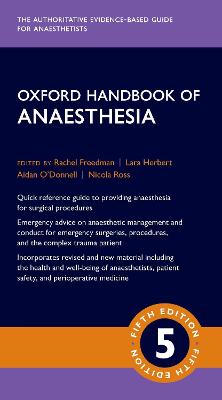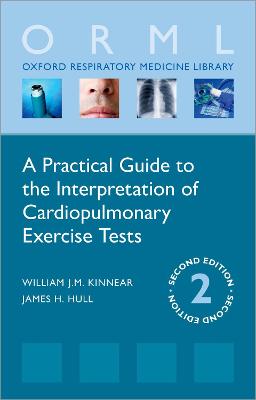Extracorporeal Membrane Oxygenation
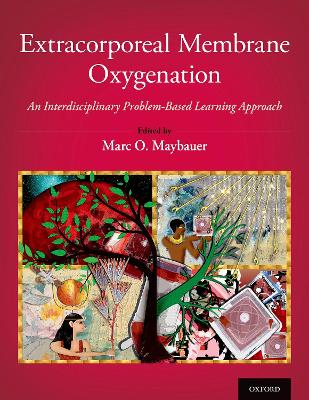 -10%
portes grátis
-10%
portes grátis
Extracorporeal Membrane Oxygenation
An Interdisciplinary Problem-Based Learning Approach
Maybauer, Marc O.
Oxford University Press Inc
06/2022
688
Dura
Inglês
9780197521304
15 a 20 dias
2110
Descrição não disponível.
HISTORY OF ECMO
1 From the first ECMO patient into the future
TECHNICAL AND PROGRAMMATIC ASPECTS OF ECMO
2 Development and staffing of an ECMO service
3 ECMO configurations and cannulation in pediatric patients
4 ECMO configurations and cannulation in adult patients
5 The ECMO circuit and trouble shooting
6 Echocardiography in the management of ECMO patients
7 Airway management in ECMO patients
8 Acute renal failure and renal replacement therapy in ECMO patients
9 Ambulance ground transportation of ECMO patients
10 Fixed-wing and helicopter air transport of ECMO patients
11 Implications and experiences with long run ECMO
ECMO BLOOD INTERACTION
12 The unholy blood - biomaterial interaction in extracorporeal
13 Heparin anticoagulation for Trans-catheter Aortic Valve Implantation on ECMO
14 Bivalirudin for alternative anticoagulation in heparin induced thrombocytopenia during ECMO
15 Argatroban for anticoagulation in pediatric and adult ECMO
16 ECMO transfusion and coagulation management
PHARMACOLOGICAL CONSIDERATIONS FOR ECMO
17 Pharmacological considerations for analgesia and sedation of ECMO
18 Challenges of antimicrobial therapy in ECMO patients
19 Vasopressor and inotropic support in ECMO patients with refractory shock
ECMO IN NEONATAL AND PEDIATRIC RESPIRATORY DISEASE
20 ECMO for Meconium Aspiration Syndrome
21 ECMO for neonatal pulmonary hypertension and associated
22 ECMO in Congenital Diaphragmatic Hernia
23 Evidence and management of rare presentations in neonatal ECMO
24 ECMO for the pediatric patient with Status Asthmaticus
25 ECMO for pediatric pneumonia and sepsis
26 ECMO in pediatric lung transplantation
27 Weaning and decannulation of neonatal and pediatric respiratory ECMO support
ECMO IN NEONATAL AND PEDIATRIC CARDIAC DISEASE
28 ECMO in pediatric patients with univentricular circulation
29 ECMO in pediatric patients with congenital heart disease
30 Extracorporeal cardiopulmonary resuscitation in children
31 ECMO as a bridge to pediatric heart transplantation
32 Weaning and decannulation of pediatric cardiac ECMO
ECMO IN ADULT RESPIRATORY DISEASE
33 Veno-venous ECMO for Acute Respiratory Distress Syndrome
34 Extracorporeal CO2 removal to enhance protective ventilation in ARDS
35 ECMO in Middle Eastern Respiratory Syndrome (MERS-CoV)
36 ECMO in SARS-CoV-2 (COVID-19) patients
37 ECMO in pregnancy and the peripartum patient
38 ECMO in sickle cell disease and acute chest syndrome
39 ECMO for severe respiratory failure secondary to HIV infection
40 Bicaval dual lumen ECMO cannulation for lung transplantation
41 Weaning and liberation from V-V ECMO
ECMO IN ADULT CARDIAC DISEASE
42 ECMO support for adults with congenital heart disease
43 ECMO for myocardial infarction with cardiogenic shock
44 ECMO support for patients with myocarditis
45 Left ventricular venting strategies during ECMO support
46 ECMO support for patients with major aortic surgery or dissection
47 Mechanical support for post-cardiotomy right ventricular failure
48 ECMO for the complicated post-cardiotomy cardiac arrest
49 ECMO for accidental hypothermia and cardiorespiratory arrest
50 ECMO support for pulmonary embolism
51 Extracorporeal cardiopulmonary resuscitation in adults
52 Bridging from ECMO to durable left ventricular assist device
53 ECMO in the management of heart transplantation
54 Weaning and liberation from V-A ECMO
ECMO IN THE ADULT TRAUMA PATIENT
55 ECMO for hemorrhagic shock after blunt trauma
56 ECMO in patients with burn and smoke inhalation injury
REHABILITATION, NEUROLOGICAL AND ETHICAL ASPECTS OF ECMO
57 ECMO in the awake patient, early extubation and physical rehabilitation
58 Neurodevelopmental outcome after pediatric cardiac ECMO support
59 Neurologic complications in adult ECMO
60 Management of ECMO complicated by intracranial hemorrhage
61 Neurological monitoring and determination of brain death in ECMO
62 Ethical considerations for ECMO initiation and end-of-life care
1 From the first ECMO patient into the future
TECHNICAL AND PROGRAMMATIC ASPECTS OF ECMO
2 Development and staffing of an ECMO service
3 ECMO configurations and cannulation in pediatric patients
4 ECMO configurations and cannulation in adult patients
5 The ECMO circuit and trouble shooting
6 Echocardiography in the management of ECMO patients
7 Airway management in ECMO patients
8 Acute renal failure and renal replacement therapy in ECMO patients
9 Ambulance ground transportation of ECMO patients
10 Fixed-wing and helicopter air transport of ECMO patients
11 Implications and experiences with long run ECMO
ECMO BLOOD INTERACTION
12 The unholy blood - biomaterial interaction in extracorporeal
13 Heparin anticoagulation for Trans-catheter Aortic Valve Implantation on ECMO
14 Bivalirudin for alternative anticoagulation in heparin induced thrombocytopenia during ECMO
15 Argatroban for anticoagulation in pediatric and adult ECMO
16 ECMO transfusion and coagulation management
PHARMACOLOGICAL CONSIDERATIONS FOR ECMO
17 Pharmacological considerations for analgesia and sedation of ECMO
18 Challenges of antimicrobial therapy in ECMO patients
19 Vasopressor and inotropic support in ECMO patients with refractory shock
ECMO IN NEONATAL AND PEDIATRIC RESPIRATORY DISEASE
20 ECMO for Meconium Aspiration Syndrome
21 ECMO for neonatal pulmonary hypertension and associated
22 ECMO in Congenital Diaphragmatic Hernia
23 Evidence and management of rare presentations in neonatal ECMO
24 ECMO for the pediatric patient with Status Asthmaticus
25 ECMO for pediatric pneumonia and sepsis
26 ECMO in pediatric lung transplantation
27 Weaning and decannulation of neonatal and pediatric respiratory ECMO support
ECMO IN NEONATAL AND PEDIATRIC CARDIAC DISEASE
28 ECMO in pediatric patients with univentricular circulation
29 ECMO in pediatric patients with congenital heart disease
30 Extracorporeal cardiopulmonary resuscitation in children
31 ECMO as a bridge to pediatric heart transplantation
32 Weaning and decannulation of pediatric cardiac ECMO
ECMO IN ADULT RESPIRATORY DISEASE
33 Veno-venous ECMO for Acute Respiratory Distress Syndrome
34 Extracorporeal CO2 removal to enhance protective ventilation in ARDS
35 ECMO in Middle Eastern Respiratory Syndrome (MERS-CoV)
36 ECMO in SARS-CoV-2 (COVID-19) patients
37 ECMO in pregnancy and the peripartum patient
38 ECMO in sickle cell disease and acute chest syndrome
39 ECMO for severe respiratory failure secondary to HIV infection
40 Bicaval dual lumen ECMO cannulation for lung transplantation
41 Weaning and liberation from V-V ECMO
ECMO IN ADULT CARDIAC DISEASE
42 ECMO support for adults with congenital heart disease
43 ECMO for myocardial infarction with cardiogenic shock
44 ECMO support for patients with myocarditis
45 Left ventricular venting strategies during ECMO support
46 ECMO support for patients with major aortic surgery or dissection
47 Mechanical support for post-cardiotomy right ventricular failure
48 ECMO for the complicated post-cardiotomy cardiac arrest
49 ECMO for accidental hypothermia and cardiorespiratory arrest
50 ECMO support for pulmonary embolism
51 Extracorporeal cardiopulmonary resuscitation in adults
52 Bridging from ECMO to durable left ventricular assist device
53 ECMO in the management of heart transplantation
54 Weaning and liberation from V-A ECMO
ECMO IN THE ADULT TRAUMA PATIENT
55 ECMO for hemorrhagic shock after blunt trauma
56 ECMO in patients with burn and smoke inhalation injury
REHABILITATION, NEUROLOGICAL AND ETHICAL ASPECTS OF ECMO
57 ECMO in the awake patient, early extubation and physical rehabilitation
58 Neurodevelopmental outcome after pediatric cardiac ECMO support
59 Neurologic complications in adult ECMO
60 Management of ECMO complicated by intracranial hemorrhage
61 Neurological monitoring and determination of brain death in ECMO
62 Ethical considerations for ECMO initiation and end-of-life care
Este título pertence ao(s) assunto(s) indicados(s). Para ver outros títulos clique no assunto desejado.
HISTORY OF ECMO
1 From the first ECMO patient into the future
TECHNICAL AND PROGRAMMATIC ASPECTS OF ECMO
2 Development and staffing of an ECMO service
3 ECMO configurations and cannulation in pediatric patients
4 ECMO configurations and cannulation in adult patients
5 The ECMO circuit and trouble shooting
6 Echocardiography in the management of ECMO patients
7 Airway management in ECMO patients
8 Acute renal failure and renal replacement therapy in ECMO patients
9 Ambulance ground transportation of ECMO patients
10 Fixed-wing and helicopter air transport of ECMO patients
11 Implications and experiences with long run ECMO
ECMO BLOOD INTERACTION
12 The unholy blood - biomaterial interaction in extracorporeal
13 Heparin anticoagulation for Trans-catheter Aortic Valve Implantation on ECMO
14 Bivalirudin for alternative anticoagulation in heparin induced thrombocytopenia during ECMO
15 Argatroban for anticoagulation in pediatric and adult ECMO
16 ECMO transfusion and coagulation management
PHARMACOLOGICAL CONSIDERATIONS FOR ECMO
17 Pharmacological considerations for analgesia and sedation of ECMO
18 Challenges of antimicrobial therapy in ECMO patients
19 Vasopressor and inotropic support in ECMO patients with refractory shock
ECMO IN NEONATAL AND PEDIATRIC RESPIRATORY DISEASE
20 ECMO for Meconium Aspiration Syndrome
21 ECMO for neonatal pulmonary hypertension and associated
22 ECMO in Congenital Diaphragmatic Hernia
23 Evidence and management of rare presentations in neonatal ECMO
24 ECMO for the pediatric patient with Status Asthmaticus
25 ECMO for pediatric pneumonia and sepsis
26 ECMO in pediatric lung transplantation
27 Weaning and decannulation of neonatal and pediatric respiratory ECMO support
ECMO IN NEONATAL AND PEDIATRIC CARDIAC DISEASE
28 ECMO in pediatric patients with univentricular circulation
29 ECMO in pediatric patients with congenital heart disease
30 Extracorporeal cardiopulmonary resuscitation in children
31 ECMO as a bridge to pediatric heart transplantation
32 Weaning and decannulation of pediatric cardiac ECMO
ECMO IN ADULT RESPIRATORY DISEASE
33 Veno-venous ECMO for Acute Respiratory Distress Syndrome
34 Extracorporeal CO2 removal to enhance protective ventilation in ARDS
35 ECMO in Middle Eastern Respiratory Syndrome (MERS-CoV)
36 ECMO in SARS-CoV-2 (COVID-19) patients
37 ECMO in pregnancy and the peripartum patient
38 ECMO in sickle cell disease and acute chest syndrome
39 ECMO for severe respiratory failure secondary to HIV infection
40 Bicaval dual lumen ECMO cannulation for lung transplantation
41 Weaning and liberation from V-V ECMO
ECMO IN ADULT CARDIAC DISEASE
42 ECMO support for adults with congenital heart disease
43 ECMO for myocardial infarction with cardiogenic shock
44 ECMO support for patients with myocarditis
45 Left ventricular venting strategies during ECMO support
46 ECMO support for patients with major aortic surgery or dissection
47 Mechanical support for post-cardiotomy right ventricular failure
48 ECMO for the complicated post-cardiotomy cardiac arrest
49 ECMO for accidental hypothermia and cardiorespiratory arrest
50 ECMO support for pulmonary embolism
51 Extracorporeal cardiopulmonary resuscitation in adults
52 Bridging from ECMO to durable left ventricular assist device
53 ECMO in the management of heart transplantation
54 Weaning and liberation from V-A ECMO
ECMO IN THE ADULT TRAUMA PATIENT
55 ECMO for hemorrhagic shock after blunt trauma
56 ECMO in patients with burn and smoke inhalation injury
REHABILITATION, NEUROLOGICAL AND ETHICAL ASPECTS OF ECMO
57 ECMO in the awake patient, early extubation and physical rehabilitation
58 Neurodevelopmental outcome after pediatric cardiac ECMO support
59 Neurologic complications in adult ECMO
60 Management of ECMO complicated by intracranial hemorrhage
61 Neurological monitoring and determination of brain death in ECMO
62 Ethical considerations for ECMO initiation and end-of-life care
1 From the first ECMO patient into the future
TECHNICAL AND PROGRAMMATIC ASPECTS OF ECMO
2 Development and staffing of an ECMO service
3 ECMO configurations and cannulation in pediatric patients
4 ECMO configurations and cannulation in adult patients
5 The ECMO circuit and trouble shooting
6 Echocardiography in the management of ECMO patients
7 Airway management in ECMO patients
8 Acute renal failure and renal replacement therapy in ECMO patients
9 Ambulance ground transportation of ECMO patients
10 Fixed-wing and helicopter air transport of ECMO patients
11 Implications and experiences with long run ECMO
ECMO BLOOD INTERACTION
12 The unholy blood - biomaterial interaction in extracorporeal
13 Heparin anticoagulation for Trans-catheter Aortic Valve Implantation on ECMO
14 Bivalirudin for alternative anticoagulation in heparin induced thrombocytopenia during ECMO
15 Argatroban for anticoagulation in pediatric and adult ECMO
16 ECMO transfusion and coagulation management
PHARMACOLOGICAL CONSIDERATIONS FOR ECMO
17 Pharmacological considerations for analgesia and sedation of ECMO
18 Challenges of antimicrobial therapy in ECMO patients
19 Vasopressor and inotropic support in ECMO patients with refractory shock
ECMO IN NEONATAL AND PEDIATRIC RESPIRATORY DISEASE
20 ECMO for Meconium Aspiration Syndrome
21 ECMO for neonatal pulmonary hypertension and associated
22 ECMO in Congenital Diaphragmatic Hernia
23 Evidence and management of rare presentations in neonatal ECMO
24 ECMO for the pediatric patient with Status Asthmaticus
25 ECMO for pediatric pneumonia and sepsis
26 ECMO in pediatric lung transplantation
27 Weaning and decannulation of neonatal and pediatric respiratory ECMO support
ECMO IN NEONATAL AND PEDIATRIC CARDIAC DISEASE
28 ECMO in pediatric patients with univentricular circulation
29 ECMO in pediatric patients with congenital heart disease
30 Extracorporeal cardiopulmonary resuscitation in children
31 ECMO as a bridge to pediatric heart transplantation
32 Weaning and decannulation of pediatric cardiac ECMO
ECMO IN ADULT RESPIRATORY DISEASE
33 Veno-venous ECMO for Acute Respiratory Distress Syndrome
34 Extracorporeal CO2 removal to enhance protective ventilation in ARDS
35 ECMO in Middle Eastern Respiratory Syndrome (MERS-CoV)
36 ECMO in SARS-CoV-2 (COVID-19) patients
37 ECMO in pregnancy and the peripartum patient
38 ECMO in sickle cell disease and acute chest syndrome
39 ECMO for severe respiratory failure secondary to HIV infection
40 Bicaval dual lumen ECMO cannulation for lung transplantation
41 Weaning and liberation from V-V ECMO
ECMO IN ADULT CARDIAC DISEASE
42 ECMO support for adults with congenital heart disease
43 ECMO for myocardial infarction with cardiogenic shock
44 ECMO support for patients with myocarditis
45 Left ventricular venting strategies during ECMO support
46 ECMO support for patients with major aortic surgery or dissection
47 Mechanical support for post-cardiotomy right ventricular failure
48 ECMO for the complicated post-cardiotomy cardiac arrest
49 ECMO for accidental hypothermia and cardiorespiratory arrest
50 ECMO support for pulmonary embolism
51 Extracorporeal cardiopulmonary resuscitation in adults
52 Bridging from ECMO to durable left ventricular assist device
53 ECMO in the management of heart transplantation
54 Weaning and liberation from V-A ECMO
ECMO IN THE ADULT TRAUMA PATIENT
55 ECMO for hemorrhagic shock after blunt trauma
56 ECMO in patients with burn and smoke inhalation injury
REHABILITATION, NEUROLOGICAL AND ETHICAL ASPECTS OF ECMO
57 ECMO in the awake patient, early extubation and physical rehabilitation
58 Neurodevelopmental outcome after pediatric cardiac ECMO support
59 Neurologic complications in adult ECMO
60 Management of ECMO complicated by intracranial hemorrhage
61 Neurological monitoring and determination of brain death in ECMO
62 Ethical considerations for ECMO initiation and end-of-life care
Este título pertence ao(s) assunto(s) indicados(s). Para ver outros títulos clique no assunto desejado.

